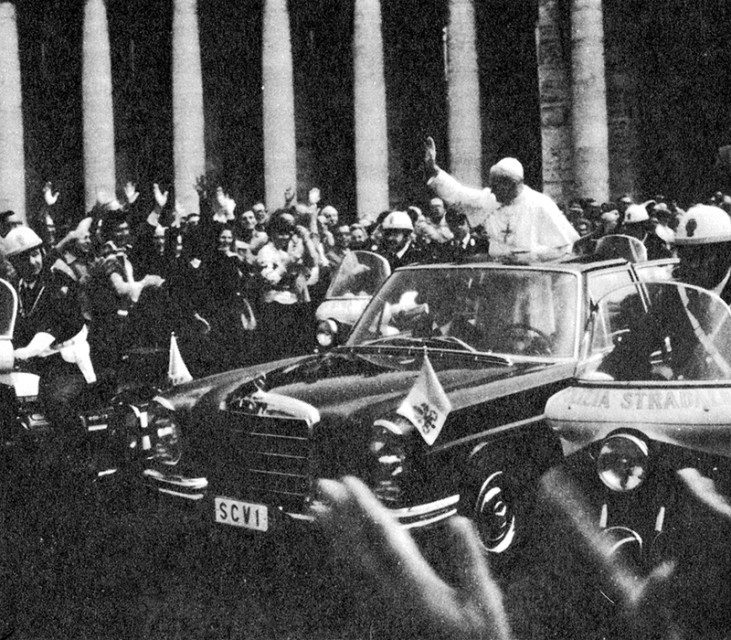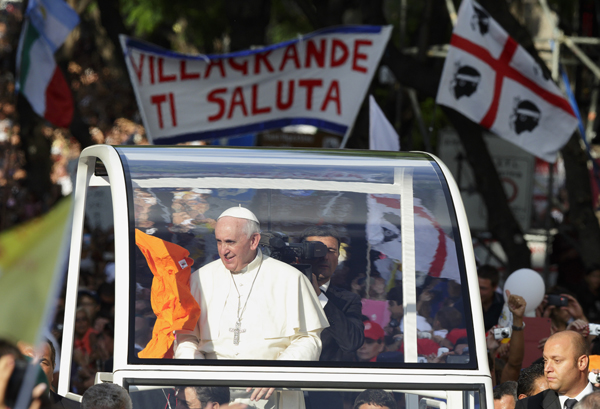
A shirt is thrown into the popemobile as Pope Francis arrives for an encounter with youth in Cagliari, Sardinia, Sept. 22. Photo by Paul Haring/courtesy Catholic News Service
VATICAN CITY (RNS) While cruising past cheering crowds in Naples, Italy, earlier this year, Pope Francis received an unexpected gift. A local pizzeria owner jogging alongside the papal car jumped over the barrier and handed Francis a pizza, which the smiling pope willingly accepted.
While the incident delighted the crowd — and most likely the pope, who loves pizza — it also exposed the pope’s vulnerability. Since his election in 2013, Francis has taken every opportunity to get close to his followers. That has included an insistence on an open vehicle — the so-called popemobile, used to transport him through cities around the globe.
In its 85-year history, the popemobile has provided popes with the ability to navigate through large crowds, making it easier for more people to see the Roman Catholic leader. But it has also undergone numerous iterations as the Vatican has tried to balance safety, accessibility, spontaneity and technological innovation.
Before the invention of the automobile, popes sat atop a throne, which was carried by 12 men dressed in red. This wasn’t a daily occurrence, however, as the throne was only brought out for special occasions in the Roman Catholic calendar.
“Papal travels are relatively new,” said Paolo Naso, a religion professor at Rome’s La Sapienza University. And they’ve been successful precisely because of advances in quick and safe transportation.
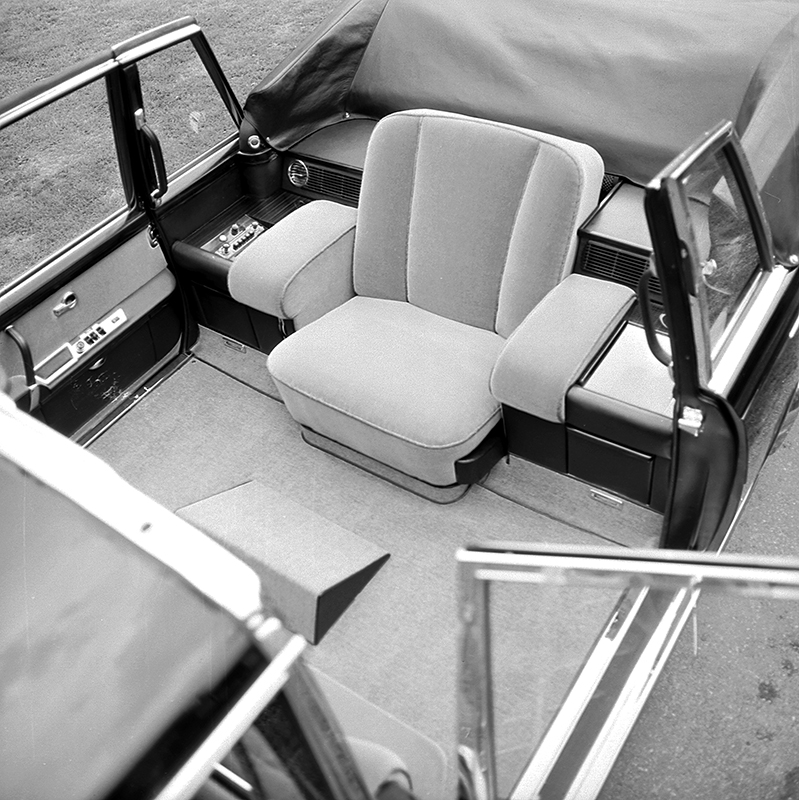
The interior of the Papal vehicle, a Mercedes-Benz type 600, that Pullman Landaulet handed over to Pope Paul VI. Photo courtesy of Mercedes-Benz
It wasn’t until 1929 that the modern-day popemobile took shape. It was German advertising executive Robert Katzenstein, working for Mercedes-Benz, who approached the German ambassador to the Vatican with the idea of creating a special vehicle for the pope.
The following year Pope Pius XI was presented with a luxury car called a Nurburg 460, which still looked like a traditional four-door sedan of the time, but had armored plates for extra protection.
More cars were custom-made by Mercedes-Benz and other companies for subsequent pontiffs, until 1981 when Pope John Paul II was shot four times while leaning out of his Fiat popemobile to greet pilgrims in St. Peter’s Square.
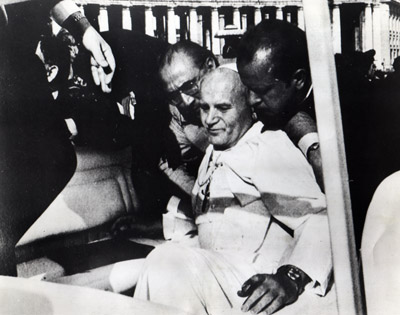
(RNS) Pope John Paul II falls in his popemobile after being shot in the abdomen by Turkish gunman Mehmet Ali Agca on May 13, 1981 in St. Peter’s Square. RNS file photo
The assassination attempt led the Vatican to significantly increase the security of the popemobile, surrounding the pontiff with bulletproof glass.
Then came Francis. Last year he described the classic popemobile as a “sardine can” and said he preferred to be able to reach out to the crowds.
“I know that something could happen to me,” he was quoted saying, “but it’s in the hands of God.”
On his first papal trip to Brazil, he was presented with a brand-new Mercedes-Benz popemobile, with open sides. He has since switched to a Hyundai car. For his upcoming visit to the U.S. Francis will ride in a Jeep Wrangler.
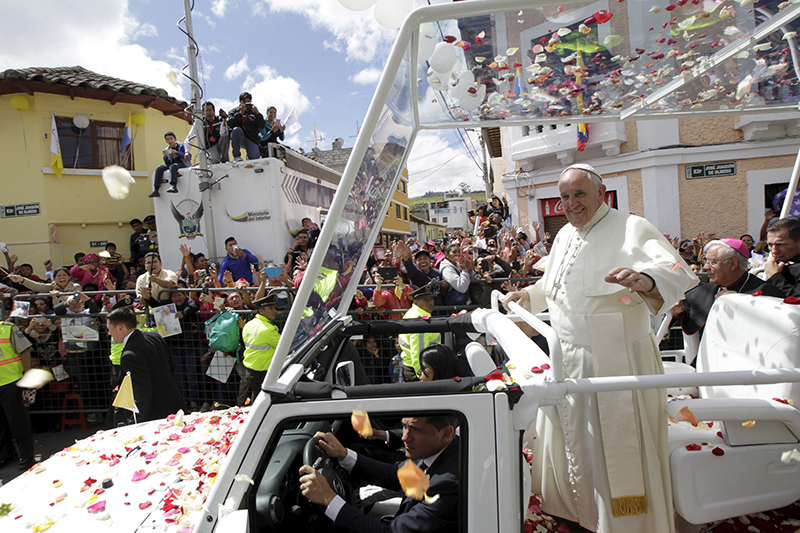
Pope Francis waves to the faithful while riding on a Jeep popemobile in El Quinche, Ecuador, on July 8, 2015. Photo courtesy of REUTERS/Guillermo Granja *Editors: This photo may only be republished with RNS-POPE-MOBILE, originally transmitted on September 2, 2015 and with RNS-POPEMOBILE-RIDE, originally transmitted on September 21, 2015.
An air cargo company has already delivered several of the Jeep popemobiles well ahead of the papal trips. For his U.S. journey, Francis will need a popemobile in Washington, New York and Philadelphia, plus a spare, in case one of them breaks down.
The Vatican as well as Jeep declined to say how much the latest popemobile costs. In the past, automakers have donated popemobiles for papal trips.
Regardless, Christian Seabaugh, an associate editor with Motor Trend magazine, said the Jeep should be a hit with the pope’s American audience.
“Pope Francis likes to have the image of a man of the people,” he said. “Jeep Wranglers are very common in the U.S. They’re accessible; they don’t scream wealth.”
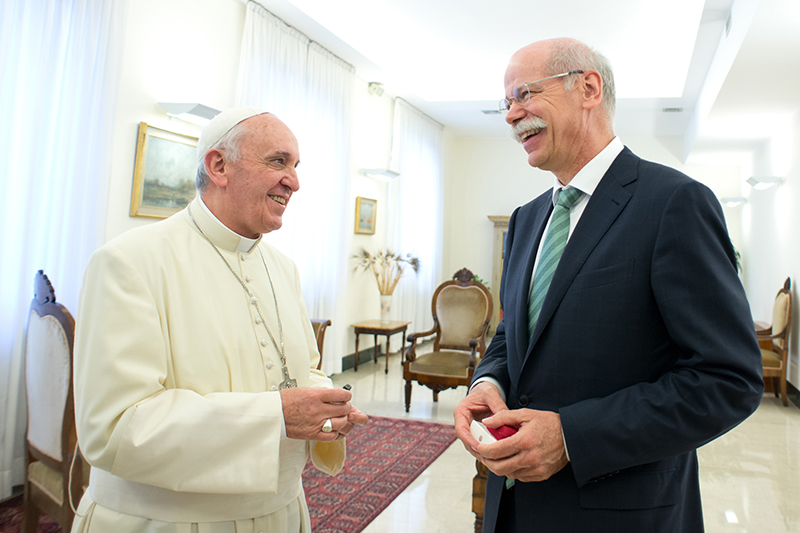
Dieter Zetsche, head of Mercedes-Benz, hands over the keys of the new popemobile to Pope Francis. Photo courtesy of Mercedes-Benz
Francis is unique among the world’s leaders in that he doesn’t travel in an armored “James Bond car,” Seabaugh said.
Presidential Cadillacs, by contrast, are protected against biological and chemical attacks and include a pressurized cabin like in an airplane. President Obama’s Cadillac, which he nicknamed “The Beast,” is usually followed by identical decoy vehicles.
Eddie Alterman, editor of Car and Driver, said the pope’s predecessor was far more secure.
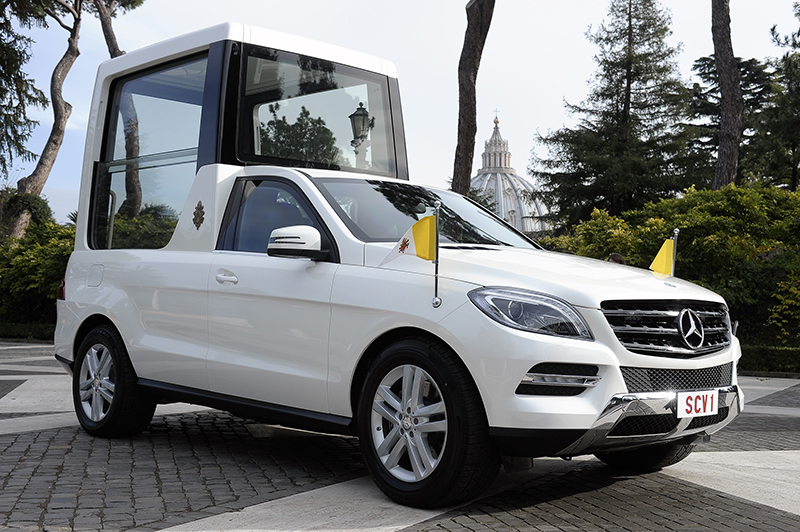
A Mercedes-Benz popemobile, used by Pope Benedict XVI. Photo courtesy of Mercedes-Benz
“Pope Benedict XVI’s most often-used vehicle was a modified Mercedes-Benz ML-class that kept the pope in a kind of bulletproof human terrarium at the back of the vehicle,” he said.
Even before Francis was elected, the Vatican switched to a hybrid gas-electric vehicle for its popemobile fleet.
Some now say he could go further, especially in light of his commitment to the environment. For example, the pope could move to a fully electric fleet.
Seabaugh pointed to one downside to fully electric cars: They need a few hours to charge.
But John McPhee, head of Green and Intelligent Automotive, or GAIA, a research facility at University of Waterloo in Canada, was more optimistic.
McPhee argued that not only would a fully electric popemobile be very low maintenance, it would also improve security since it accelerates faster than a conventional car.
Both Seabaugh and McPhee agreed: If any leader were to begin using an electric car, surely it would be this pope.
(This story is part of a series on the papal visit produced in collaboration with USA Today.)
YS/AMB END SCAMMELL
